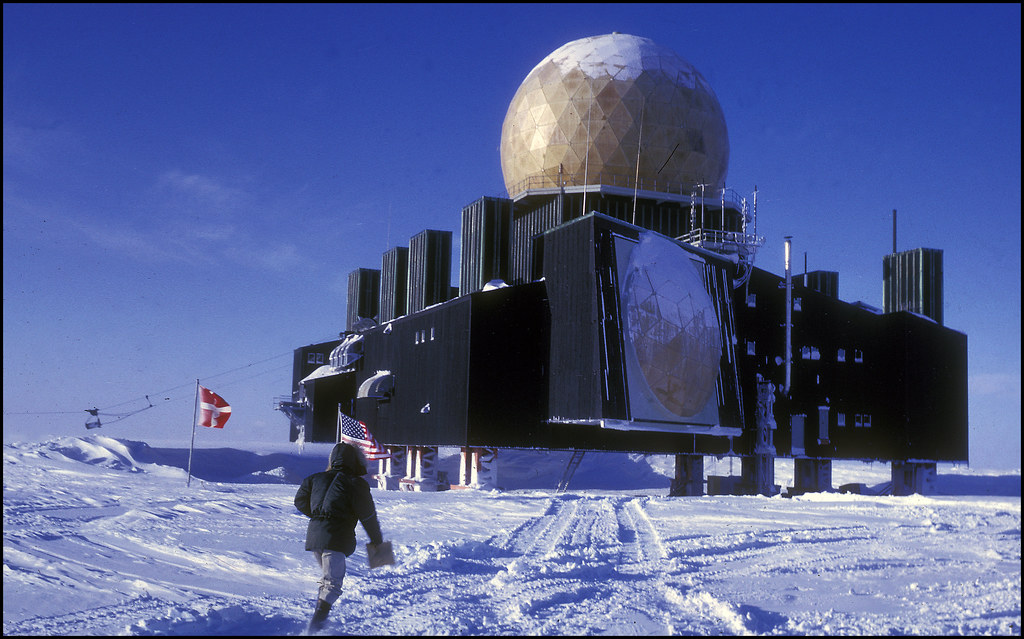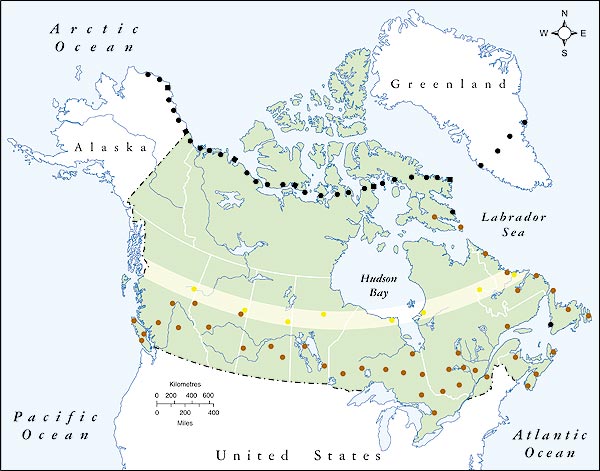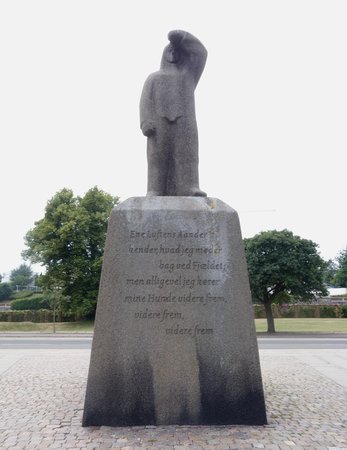I know, objectively, that the Cold War was a serious matter, and that it caused some major political tensions all across the globe, but in retrospect, it's a little funny. The sheer amount of paranoia and fear of communist nations caused the United States to do some crazy things, and occasionally they dragged Canada, the mild mannered cousin of North America, into their nonsense. There's lots of crazy shenanigans to talk about, but today let's focus on the time that America essentially built a fence in the middle of Canada's yard, and Canada had to pretend that they were cool with it so the local Homeowner's Association didn't think they were weak.
Brought to you by AT&T, the Distant Early Warning Radar Line, or the DEW line, is a line of radar stations stretching from the arctic coasts of east of Alaska to the ice sheets of Greenland. Mostly abandoned now, the DEW line was constructed in the late 1950s to provide early warnings should the Soviet Union decide to launch nuclear missals so far north they started to come south.
This genius idea was the brain child of American scientists from the Massachusetts Institute of Technology (MIT), and Robert A. Lovett, the US Secretary of Defense, latched onto the idea immediately. Before even pitching the idea to his counterparts in Ottawa, he called up Cleo F. Craig, CEO of AT&T, and asked him to start working on something. Craig put his best men on the job.
When Lovett did get around to telling the Canadians his plans, the Canadian government was less than amused. While they had signed a treaty in the 1940's saying that they wouldn't allow foreign attackers into America from their territory, and despite the fact that Canada was in just as much danger from a Soviet attack as Russia was, Ottawa had several reservations, mainly the cost and the loss of sovereignty over their Arctic territories.
Canada has always been a bit sensitive about its Arctic regions. While the Canadian government has had very little interest in developing the Yukon, Nunavut, and the Northwest Territories, they sure want to hang on to them. The American government sniffing around the arctic wasn't uncommon, and lead to Canadian efforts like the relocation of the Arctic Exiles to keep the Americans out. Since it was proposed that American military personnel would build and staff the stations on the DEW line, the Canadian government was worried that de facto arctic sovereignty would pass to the United States due to lack of Canadian presence.
Additionally, the Canadian economy wasn't doing too great. They were already spending half of their budget on defense, and the money required to build the DEW Line would require increasing their military budget by 6%. Canada just wasn't down for that.
However, Canada needed to keep up appearances. They instructed their PR teams to only refer to the DEW line as a joint project between the US and Canada, and to make sure that it didn't seem as if the US was giving Canada aid. Once the line was finished, several members of the RCMP (mounties), were sent to Stations on the DEW line. As many Canadians were put into leadership positions as possible. Canada did their best to make it seem like the DEW line had been their idea.
The United States also built a little bit of that fence in Greenland's yard, however, as far as my research proves, the Greenlanders didn't really care. It's possible that there was a massive uproar, but it's also very possible that both Copenhagen and Nuuk just didn't care about the United States challenging its arctic sovereignty. Historically, because of its inhospitable climate very few nations have actually wanted to own Greenland, though should the nation start tapping its plentiful oil wells, that could certainly change. The stations in Greenland were more of an after thought than anything; no one seriously expected a Soviet attack through Greenland.
The DEW line was abandoned in 1985 in favor of the Northern Warning System. Many of the stations were dismantled, and hauled away for parts but there are still several abandoned stations across Alaska, Canada, and Greenland. Building it took three years, and cost something around 750,000 million United States dollars.
Sources
Adventures from the Coldest Part of the Cold War
The Distant Early Warning Line, and the Canadian Battle for Public Perception
Distant Early Warning Line (DEW Line)
DYE-2 A Relic From a Not So Distant Past
The Distant Early Warning (DEW) Line
 |
| Greenland DEW Station |
This genius idea was the brain child of American scientists from the Massachusetts Institute of Technology (MIT), and Robert A. Lovett, the US Secretary of Defense, latched onto the idea immediately. Before even pitching the idea to his counterparts in Ottawa, he called up Cleo F. Craig, CEO of AT&T, and asked him to start working on something. Craig put his best men on the job.
When Lovett did get around to telling the Canadians his plans, the Canadian government was less than amused. While they had signed a treaty in the 1940's saying that they wouldn't allow foreign attackers into America from their territory, and despite the fact that Canada was in just as much danger from a Soviet attack as Russia was, Ottawa had several reservations, mainly the cost and the loss of sovereignty over their Arctic territories.
 |
| Black dots are DEW stations |
Additionally, the Canadian economy wasn't doing too great. They were already spending half of their budget on defense, and the money required to build the DEW Line would require increasing their military budget by 6%. Canada just wasn't down for that.
However, Canada needed to keep up appearances. They instructed their PR teams to only refer to the DEW line as a joint project between the US and Canada, and to make sure that it didn't seem as if the US was giving Canada aid. Once the line was finished, several members of the RCMP (mounties), were sent to Stations on the DEW line. As many Canadians were put into leadership positions as possible. Canada did their best to make it seem like the DEW line had been their idea.
 |
| DEW emblem |
The DEW line was abandoned in 1985 in favor of the Northern Warning System. Many of the stations were dismantled, and hauled away for parts but there are still several abandoned stations across Alaska, Canada, and Greenland. Building it took three years, and cost something around 750,000 million United States dollars.
Sources
Adventures from the Coldest Part of the Cold War
The Distant Early Warning Line, and the Canadian Battle for Public Perception
Distant Early Warning Line (DEW Line)
DYE-2 A Relic From a Not So Distant Past
The Distant Early Warning (DEW) Line

